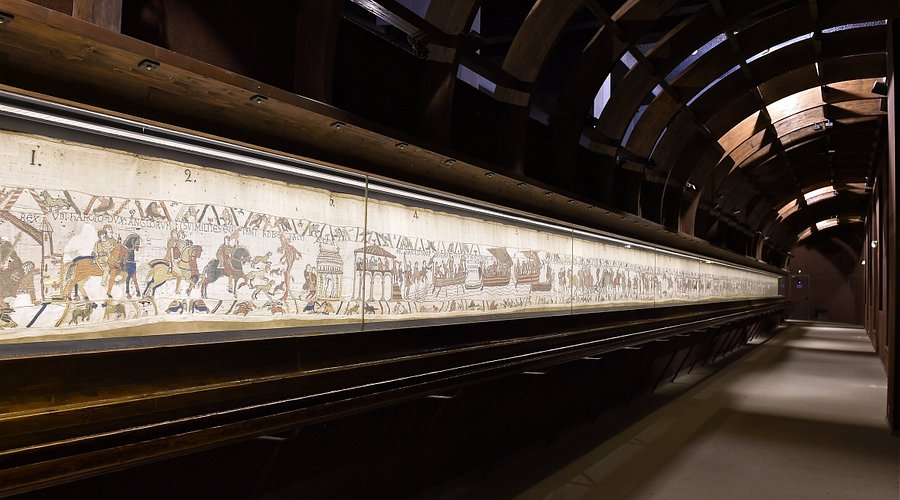Institution to End Visits on August 31, 2025, and Reopen Only in 2027
Since the dawn of humanity, art has been a powerful tool for recording and interpreting historical conflicts. Iconic works such as Picasso’s Guernica, which condemns the horrors of the bombing of the Spanish city during the Civil War, or Goya’s dramatic Disasters of War, depicting the brutalities of the Napoleonic invasion of Spain, serve as visual testimonies of turbulent times. However, few historical pieces convey the complexity of a military event with the richness of detail and narrative sophistication of the Bayeux Tapestry, one of the most significant visual records of the Middle Ages.
Created in the 11th century, this monumental embroidered tapestry, measuring approximately 70 meters in length and 70 centimeters in height, is much more than a mere work of art. It functions as a detailed historical document that narrates the events leading up to the Norman conquest of England in 1066, culminating in the famous Battle of Hastings. Under the command of William, Duke of Normandy, later known as William the Conqueror, the Norman invasion marked a pivotal turning point in English history, establishing a new dynasty and redefining the political and cultural landscape of England.

The authorship of the tapestry remains a mystery to this day. There are no precise records of who embroidered it, but historians believe it was commissioned by Odo, Bishop of Bayeux and half-brother of William, as a means to glorify the Norman victory and consolidate the power of the new dynasty. The initial goal was to adorn the nave of the newly consecrated Notre-Dame Cathedral of Bayeux, whose inauguration occurred in 1077.
Although often referred to as a “tapestry,” the piece is technically an embroidered linen, using wool threads dyed in vibrant shades of green, blue, red, yellow, and black. This combination of colors, alongside the sequential narrative in images and Latin texts, creates a captivating visual effect capable of conveying complex stories to an audience that was largely illiterate at the time.
The tapestry goes beyond simply narrating military events, offering a vivid portrayal of 11th-century Norman and Anglo-Saxon society. In its detailed scenes, one can observe aspects of everyday life, such as clothing, weapons used in battles, ships, banquets, hunting scenes, and even moments of humor and satire.
Among the most famous representations is the scene in which the Anglo-Saxon king Harold II, the last Anglo-Saxon monarch of England, is struck by an arrow in the eye during the Battle of Hastings. This episode symbolizes the fall of the Anglo-Saxon dynasty and the beginning of the Norman era in England. Another fascinating detail is the inclusion of Halley’s Comet, depicted as an omen of the catastrophic events to come. Interestingly, this is one of the oldest known depictions of the comet, which would not be named Halley until six centuries later, in honor of astronomer Edmond Halley.
The tapestry also reveals important political aspects, such as Harold’s oath to William, which was allegedly broken when Harold took the English throne, providing justification for the Norman invasion.
Over the centuries, the Bayeux Tapestry has survived wars, fires, and even attempts at destruction. During the French Revolution, for example, the piece was nearly used as a canvas to cover military carts. Fortunately, it was rescued and preserved, eventually becoming one of France’s most important historical artifacts.
Since 1983, the tapestry has been displayed at the Grand Séminaire of Bayeux, a historic building in the heart of Normandy, as part of the city’s museum complex. This complex also includes the Normandy Landing Memorial, dedicated to D-Day in 1944, and the Baron Gérard Museum of Art and History, with a vast collection of regional artifacts.
In 2024, around 600,000 visitors passed through the museums of Bayeux, mainly drawn by the tapestry. Tourists from the UK and the US lead the number of international visitors, highlighting the global appeal of this masterpiece.
Soon, this historical gem will undergo one of its most complex preservation phases. The museum will close on August 31, 2025, at 7:00 PM (local time), to begin an extensive renovation, with reopening scheduled for October 2027. The closure will allow for the execution of a meticulous restoration and modernization plan for the facilities.
The 2027 reopening was not chosen by chance. The date coincides with the celebration of the 1,000th anniversary of William the Conqueror’s birth, a historic milestone of great significance for Normandy and the United Kingdom.
The renovation project will be led by the renowned British architecture studio RSHP (Rogers Stirk Harbour + Partners), recognized for its commitment to preserving cultural heritage. The works will include the construction of a new wing at the Grand Séminaire, which will double the exhibition space dedicated to the tapestry.
The total budget for the renovation is 38 million euros, funded by a consortium formed by the City of Bayeux, the French State (official owner of the tapestry), the Calvados Departmental Council, and the Normandy Regional Council.
The restoration of the tapestry will be an unprecedented technical challenge. Although its original colors have remarkably remained vibrant over the centuries, some sections underwent inappropriate interventions in the 19th century, resulting in faded and weakened areas.
The restoration process will begin in January 2025 with the removal of the wool lining added in 1983, allowing for a more accurate analysis of the embroidered linen’s condition. Specialized technicians will conduct a thorough cleaning of the fabric and apply specific treatments to stabilize damaged areas.
Additionally, the tapestry will be photographed in ultra-high resolution, creating a complete digital record of the work. This mapping will enable continuous monitoring of the piece’s condition and assist in future restoration efforts.
During the museum’s closure, the tapestry will be carefully packed into climate-controlled conservation boxes and transferred to a safe location, where it will continue to be studied by experts.
According to Antoine Verney, Chief Curator of the Bayeux Museums, the museum will transform into a true laboratory during the works: “During the periods when the museum is closed to the public, the exhibition structure can be moved within the building, allowing for in-depth studies, detailed photographs, and continuous monitoring of the tapestry.”
The new exhibition space will feature advanced technologies, including digital projections and interactive panels, allowing visitors to explore the finest details of the tapestry without compromising its integrity. The exhibition support will be angled, providing better visibility and ensuring greater protection from gravity and natural wear.
Moreover, the new facilities will offer educational areas dedicated to explaining the historical context of the tapestry, from the Norman conquest to its rediscovery and the challenges of its preservation.
The Bayeux Tapestry will not be the only French cultural relic undergoing renovations in the coming years. The Centre Pompidou in Paris, known for its bold 1970s architecture, will also close for an extensive renovation. The Paris museum will cease its activities in the second half of 2025 and remain closed for at least five years.
Despite these temporary closures, there are high expectations that the renovations will further boost cultural tourism in France, offering visitors more enriching and technological experiences, without compromising the integrity of the works.
The Bayeux Tapestry is more than a medieval decorative piece — it is a visual testimony of one of the most important events in European history. Its preservation is crucial for future generations to admire and understand the complex cultural, political, and social interconnections that shaped the modern world.
While the museum remains closed for renovations, the public will be able to explore digital versions of the tapestry, available on online platforms, ensuring that this masterpiece remains accessible even during the restoration process.
When the museum doors reopen in 2027, it will mark the beginning of a new chapter in the long history of the Bayeux Tapestry, solidifying its place not only as a medieval artifact but as an eternal symbol of historical memory and narrative art.

